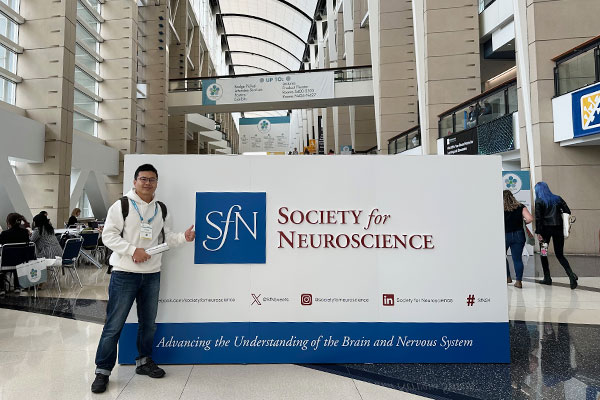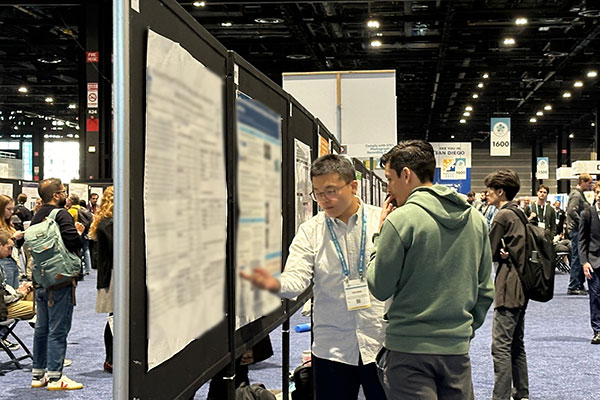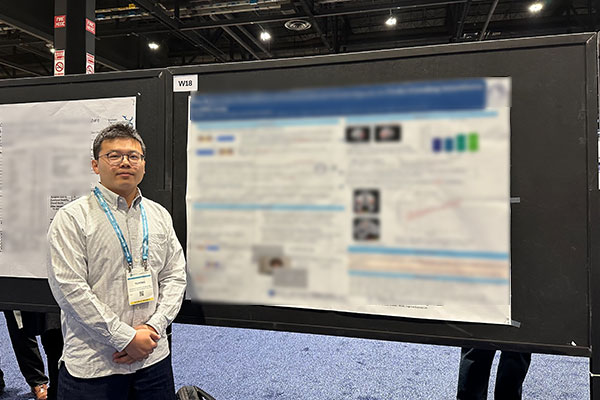Topics
2024.10.3
NGP Felloship Report:Society for the Neuroscience 2024 in Chicago.
School of Medicine
D1 LIU Yuyong
The Society for Neuroscience (SfN) is one of the largest and most prestigious gatherings in the field of neuroscience. Held annually, this conference brings together neuroscientists from around the world to share their latest research, network with colleagues, and explore new advancements in the study of the brain and nervous system. The 2024 53rd annual meeting took place in Chicago from October 5-9. Around 20,000 researchers from over 80 countries gathered in McCormick Place Convention Center. We had the opportunity to participate in a wide range of scientific sessions, poster presentations, and workshops. The conference also featured keynote addresses, symposia, and special interest group meetings, providing a comprehensive overview of the current state of neuroscience research. Networking opportunities were abundant, with social events, meet-ups, and satellite sessions designed to foster collaboration and exchange of ideas. The meeting also included an exhibit hall with the latest tools, technologies, and resources for neuroscience research.
When I entered the hall of the conference venue, I was immediately struck by its immense scale and grandeur. The space was bustling with activity, as a diverse crowd of attendees from various countries mingled and exchanged ideas. It was truly an international gathering, showcasing the global nature of the neuroscience community. In addition, numerous companies showcased their latest devices and technologies for neuroscience research. From state-of-the-art microscopes and electrophysiology equipment to cutting-edge data analysis software, the exhibit hall was a treasure trove of tools and resources that promised to advance the field even further.
The opening lecture was a fascinating exploration of the intersection between art and neuroscience, a burgeoning interdisciplinary field that researchers have aptly named "neuroarts." This emerging domain holds immense potential and requires extensive research to fully understand the intricate relationship between artistic expression and brain function. Art, in its myriad forms, plays a crucial role in human life and culture. It not only enriches our experiences but also has profound psychological and emotional benefits. Recent studies have shown that engaging in art activities allows us to feel more deeply and think less critically, tapping into our emotions and fostering a sense of creativity and mindfulness. This insight is particularly inspiring to me, as it highlights the transformative power of art and its ability to enhance our well-being. The lecture underscored the importance of continued exploration in this field, as understanding the neural underpinnings of artistic processes could lead to new therapeutic approaches and enhance our appreciation of art's impact on the human brain. It was a thought-provoking and enlightening session, setting the tone for a conference that promises to push the boundaries of our knowledge.
The research I presented was to unravel the neural mechanisms of communication. In face-to-face conversations, the onset of conversational facial signals usually comes earlier than the speech. What is the role of the precedence of facial signals? The present study created videos where the timing of facial signals and speech is manipulated and let participants watch the videos in the MRI. The results reveal that he precedence of facial signals helps to efficiently predict speakers' intentions based on facial motion perception, and that people who are more responsive to others show more sensitivity to the timing of facial signals.
I received valuable feedback from the audience after my presentation. One particularly engaging discussion was with a researcher from China, who shared her pioneering work on using implanted chips to record neural activity in patients during their everyday conversations over the course of a week. This innovative approach provided fascinating insights into the dynamics of neural communication in real-world settings. In another enlightening conversation, I delved into the technical intricacies of fMRI data analyses with a fellow researcher. Our discussion focused on connectivity analysis, a crucial aspect of understanding the functional interactions between different regions of the brain. This exchange was immensely beneficial, as it deepened my understanding of the methodologies involved and highlighted new potential areas for exploration. The benefits of these conversations were multifaceted. Engaging with researchers from diverse backgrounds allowed me to gain a better understanding of the research environment in China. This knowledge is particularly advantageous for me if I decide to pursue research opportunities there in the future. Moreover, the insights and ideas generated from these discussions have sparked new directions for my own research. I now have fresh perspectives on experimental design and methodological approaches that could enhance the scope and impact of my future studies.
Several posters at the conference left a lasting impression on me. Although the researchers behind these posters did not use fMRI, they employed other fascinating techniques such as EEG, iEEG, and single neuron recording to explore communication-related phenomena. The diversity of methods showcased in these studies was truly eye-opening and made me realize how narrow my focus had been previously. Each of these methodologies offered unique insights into neural communication, highlighting the versatility and potential of different approaches in neuroscience research. The posters demonstrated that even without fMRI, it is possible to obtain valuable and meaningful data that can contribute significantly to our understanding of the brain. This realization has inspired me to broaden my horizons and consider a wider range of techniques in my future research. Embracing these diverse methods will allow me to tackle research questions from multiple angles and enhance the robustness of my findings. I am now more determined than ever to explore new possibilities and integrate various methodologies to solve complex research questions in my ongoing and future studies.
I also attended several excellent lectures, one of them is "The Predictive Coding of Voluntary Self-Motion: Circuits for Action and Perception". This lecture explored the neural circuits involved in predicting and processing self-generated movements, providing a comprehensive overview of how the brain integrates sensory information and motor commands to create coherent perceptions and actions. The insights gained from this research have profound implications for understanding motor control and perception. Another fascinating lecture was titled "Uncovering Principles of Nervous System Design and Function in Simple Animals." This presentation highlighted the advantages of studying simpler organisms to elucidate fundamental principles of nervous system organization and function. By examining these basic models, researchers can gain insights that are applicable to more complex systems, shedding light on the universal principles that govern neural function across species.
Overall, attending the conference was an incredible opportunity. I am truly grateful for the chance to be a part of such a prestigious event, and I would like to extend my heartfelt gratitude to the NGP.



